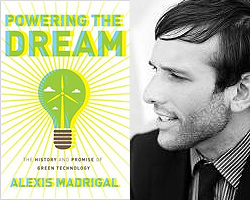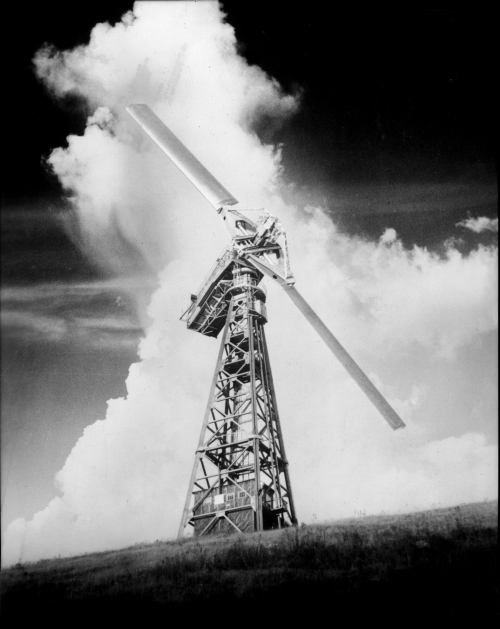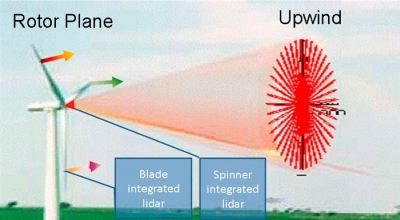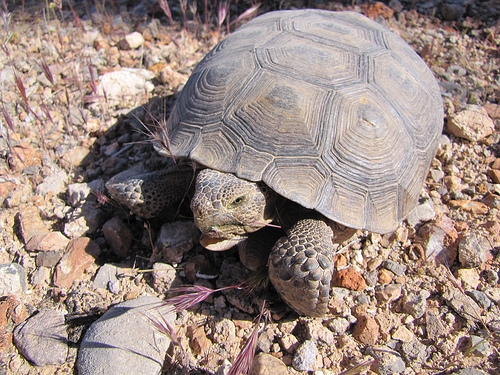 This is the fourth in a series from my conversation with Atlantic tech channel editor Alexis Madrigal about themes and stories from his new book, Powering the Dream: The History and Promise of Green Technology.
This is the fourth in a series from my conversation with Atlantic tech channel editor Alexis Madrigal about themes and stories from his new book, Powering the Dream: The History and Promise of Green Technology.
DR: Something that comes up again and again in your book is this seemingly irreducible mystery of wind and how it moves. The wind industry starts with all these windmills on farms, then up to the big turbines, all in the absence of any sophisticated scientific knowledge about how wind works.
AM: There’s this big debate in the history of technology around the role of vernacular knowledge — whether science has to lead technology or if technology can find ways to harness stuff without really knowing how it works.
 Wind Motor windmill at Mott, North Dakota, circa 1910.Photo: Windmillers’ Gazette
Wind Motor windmill at Mott, North Dakota, circa 1910.Photo: Windmillers’ Gazette
Wind is a fascinating example where trying to lead with too much science, the aeronautics approach, actually wasn’t good. If you look at the way the Danish built their wind power industry, the people who were building and operating the wind machines were tied into the research apparatus. It’s one of the sterling examples of an innovation ecosystem that really, really worked: a tiny little country that decided they were going to have a wind industry. In order to get government backing, [the industry] focused on reliability. These decisions made their machines slower-moving — they didn’t progress as quickly as our American machines — but over time, they just worked better.
That has a lot to do with [competitive] American notions about how you get funding for a company. You have to project certain levels of performance, and those often don’t take into account operations and maintenance. This Danish innovation ecosystem was more cooperative between companies. It was more holistic in its approach to a good wind machine: It wasn’t just the most technically efficient on paper, it was rooted in what’s the best overall machine for doing the work.
The Danes were also really good at countercyclical investment. When their wind industry would collapse, that’s when they would provide money. It kept a lot of wind people in the industry, kept a lot of vernacular knowledge, things that hadn’t been written down or systematized. One thing you see in the U.S. time and again is that when our [renewable energy] industries collapse, there’s no support from the government to keep those people in think tanks or research firms.
 The Smith-Putnam 1.25 MW wind turbine, circa early 1940s. In 1945 it threw a blade and was dismantled.Photo: Paul Gipe, Wind-Works.org
The Smith-Putnam 1.25 MW wind turbine, circa early 1940s. In 1945 it threw a blade and was dismantled.Photo: Paul Gipe, Wind-Works.org
DR: Your book is about a series of failures, but it shows that there are better and worse failures. Some increase our knowledge, but in some cases, a bunch of work and thought and science just goes poof. How do we fail well in greentech?
AM: The key thing is, we know that most startups are going to fail. The No. 1 policy we could put into place would be to make sure that companies taking government money — on the assumption that it’s a public good they’re doing — have to give up some of their data on how well things worked, how well things didn’t work. Create a library of failure and success. That would be incredibly useful.
Go back and look at all of those ’80s wind companies. Maybe some of them were doing great, and they just collapsed because the leader of the company was a cokehead. We don’t know why a lot of places fail.
This should be a conservative argument: If the American taxpayer going to pay to support the development of these technologies, we want to get the most return on our investment. The key is recording and sharing information. Even though they don’t exist now, there could be structures and policies in place to make that happen.
DR: In the book, you say that the U.S. homebuilding industry “replaced architecture with energy.” It expanded too fast to have any time to pay attention to orientation or efficiency. That’s one of several instances where clean energy has this kind of stubborn dependence on site-specific knowledge. It’s true for solar, it’s true for wind. It’s hard to scale something up when you have this need for details about each individual site. Isn’t that a disadvantage?
AM: That’s definitely true. Think about building a coal plant: you build an entirely human environment. You can control everything about that system, all you need is the materials to make it run. With renewable energies, taking advantage of natural energy flows, you have to know what the natural energy flow is.
We’re actually riding a pretty good technological wave there. We’re understanding way more about solar radiance and how it works, how the wind works. Wind is just air moving, so it has a lot to do with weather projections, climactic projections. Those are things where increasing amounts of computing power are incredibly helpful.
 Laser-based wind sensing, by researchers at Risø DTU.Image: Risø DTUThere are things on wind machines now that allow them to adjust to the wind that’s coming at them, as opposed to the wind that just went by them, which is how they work now. That sort of stuff will have a major impact as time goes on.
Laser-based wind sensing, by researchers at Risø DTU.Image: Risø DTUThere are things on wind machines now that allow them to adjust to the wind that’s coming at them, as opposed to the wind that just went by them, which is how they work now. That sort of stuff will have a major impact as time goes on.
Technologists think that in the future there will be sensors everywhere, and we’ll have the computing power to crunch the data. Individual people won’t have to know as much about a specific site because the computing network will know more about that site. I feel dangerously techno-utopian on this particular point. It might not work; it might be an irreducible problem. But if there is one space where I’m willing to say that tremendous things are happening, it is around large-scale computing being able to reduce uncertainty around complex systems.
My other great source of optimism is that material science will deliver us some amazing photovoltaic materials. We’re just at the beginning on photovoltaic. I know it’s been 50-plus years since we figured out the basics, but right now there’s so much work being done in material science to harness it to computing power, we’re going to see a lot of change. It’s exciting talking to material scientists right now because they’re getting somewhere. It’s one of those things where we won’t see the fruits for 10 or 20 years, but we’ll look back and see it as a key enabling infrastructural technology.
Next: Madrigal and I talk over a controversial suggestion for how to break the political logjam.



